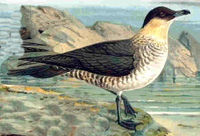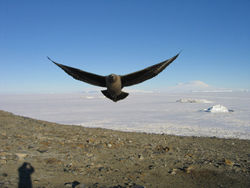|
Skuas |

Pomarine Skua
|
|
Scientific classification |
| Kingdom: |
Animalia
|
| Phylum: |
Chordata
|
| Class: |
Aves
|
| Order: |
Charadriiformes
|
| Family: |
Stercorariidae
Gray, 1871 |
| Genus: |
Stercorarius
Brisson, 1760 |
|
The skuas are
seabirds in the family Stercorariidae. The three
smaller skuas are called jaegers in North America.
The name skua comes from
Faroese skúgvur [ˈsgɪgvʊɹ]
(Stercorarius skua), and the island of
Skúvoy is renown for its colony of that bird. Jaeger is
derived from the German word Jäger, meaning hunter.
Skuas nest on the ground in temperate and arctic regions
and are long-distance
migrants.
Outside the breeding season they take fish, offal and
carrion. Many are partial kleptoparasites, chasing gulls,
terns and other seabirds to steal their catches; the larger
species also regularly kill and eat adult birds, up to the
size of Great Black-backed Gulls. On the breeding grounds
they commonly eat lemmings, and the eggs and young of other birds.
They are in general medium to large
birds, typically with grey or brown plumage, often with
white markings on the wings. They have longish bills with a
hooked tip, and webbed feet with sharp claws. They look like
large dark gulls, but have a fleshy cere above the upper
mandible. They are strong, acrobatic fliers.

Skua in
Antarctica
Skuas are related to
gulls,
waders,
auks
and
skimmers. In the three smaller species (all Holarctic),
breeding adults have the two central tail feathers obviously
elongated and at least some adults have white on the
underparts and pale yellow on the neck, characteristics that
the larger species (all native to the Southern Hemisphere
except for the Great Skua) do not share. Therefore the skuas
are often split into two genera with only the smaller
species retained in Stercorarius, and the large species
placed in Catharacta. However, there is no genetic basis for
this separation. The Pomarine and Great Skuas' mitochondrial
DNA (which is inherited from the mother
only) is in fact more closely related to each other than it
is to either Arctic or Long-tailed Skuas, or to the Southern
Hemisphere species.
Thus, hybridization must have played a considerable role in
the evolution of the diversity of Northern Hemisphere skuas.
"Skua" is also a slang term at American
Antarctic research stations such as the McMurdo Station or
the Amundsen-Scott South Pole Station. It is named for the
bird, and it means to salvage or scavenge for equipment or
gear.
Species
- Long-tailed Skua or Long-tailed Jaeger, Stercorarius
longicaudus
Arctic Skua or Parasitic Jaeger, Stercorarius
parasiticus
Pomarine Skua or Pomarine Jaeger, Stercorarius pomarinus
Chilean Skua, Stercorarius chilensis
South Polar Skua, Stercorarius maccormicki
Brown Skua, Stercorarius antarctica
Great Skua Stercorarius skua
Reference
- Seabirds by Harrison,
ISBN 0-7470-1410-8
External links




